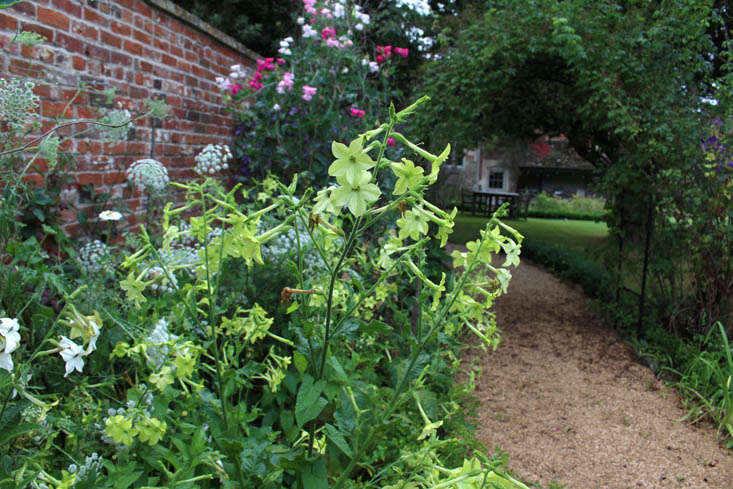On driving through Wiltshire at the beginning of August I was amazed to see the sweet peas of my friend Charlotte-Anne Fidler in such fine fettle. But then, she is the kind of person who doesn’t countenance failure; in her search for sweet pea perfection she sourced this year’s bumper crop from expert grower Philip Johnson of Johnson’s Sweet Peas, who ships his seeds worldwide.
After a short recess, it’s time to start thinking about sweet peas again; sow them in October for a strong showing in spring. But which to choose? We ask the customer and the supplier: Charlotte and Philip.
Photography by Kendra Wilson, except where noted.
Above: Charlotte-Anne Fidler’s garden (as well as her photogenic Maine Coon cats), has attracted a large Instagram following to @charlotte_annefidler. Here, Nim investigates a small selection from the cutting garden.
Charlotte: “I found Philip Johnson online. I loved the descriptions of the varieties he supplies; they sounded absolutely delicious. They are mostly blousy Spencer-types, which for me are what sweet peas are all about.”
Philip: “In the UK the Spencer varieties are probably the most popular type of sweet peas. They are characterized by having relatively long stems; usually four large, waved blooms, and a good but fairly ‘simple’ scent. These formed the majority of the varieties chosen by Charlotte this year.”
Above: Charlotte and her husband, Matthew, make three oversized wigwams from hazel every spring. To allow sweet peas to grow as large as they want (more than six feet high), supports need to be made on site. In the UK, check online for suppliers of peas sticks and bean poles from managed woodland.
Above: Sweet peas ‘Valerie Harrod’ (£1.25 for a packet of seeds from Johnson’s) and ‘White Frills’.
Charlotte: “Philip’s sweet peas arrived in late March looking strong and healthy. They withstood even the hideously cold weather we had in April this year. When I was worried about how some of them were doing after the late frosts, Philip sent me a brilliant email full of advice and reassurance.”
Philip: “I am also happy to grow plants to order.”
Above: Sweet pea ‘Valerie Harrod’, with Ammi Majus. Growing sweet peas from seed is obviously much cheaper than ordering small plants; the outlay is in time and effort. To avoid spindly home sown seedlings, grow them hard, Philip says.
Sweet peas sown in October or November produce bigger plants. Keep them in a cold frame or somewhere sheltered outdoors; winter weather will create tougher plants. If you forget to sow them early, or would like your sweet peas to flower later, sow them in spring, starting them off indoors.
Above: Charlotte’s cutting garden in August.
Charlotte: “I’m a newbie with growing from seed. I have a wonderful neighbor who grows all my Nicotiana, Ammi, foxgloves, and zinnias for me, so with sweet peas, I buy plug plants. I find that autumn sown sweet peas are always more successful than spring sown ones.
“This is my third year with the cutting garden. I’ve learnt what flowers I like and what flowers are a waste of time. I plan each section so that it looks good while growing; for instance this year we’ve had the acid greens of Nicotiana and Euphorbia mixed with multi-colored zinnias. I like the way it starts off so neat and regimented, like a vegetable garden, and then everything becomes huge and tumble-y, all in one season.”
Above: Sweet pea ‘Milly’, a Spencer type is £1.25 per packet of seeds from Johnson’s.
Philip: “Besides Spencer, another popular group has several names but is usually called Old-Fashioned. These have relatively short stems, two or three ‘plain’ blooms and often an intense ‘complex’ scent.
“A less known third group is Modern Grandiflora, roughly intermediate between Spencer and Old-Fashioned. Amongst them are some of the most scented sweet peas.” This group includes the much-loved ‘Matacuna’.
Above: Sweet pea ‘Blackberry’ is £1.25 per packet of seeds from Johnson’s.
Charlotte: “Philip creates blends, and he’s clever with color combinations. ‘Blackberries and Cream’ is a blend of two Modern Grandiflora varieties, ‘Blackberry’ and ‘Cathy’.”
Above: Sweet pea ‘Valerie Harrod’ is joined by ‘White Frills’ and ‘Anniversary’ (white, with a pink picotee edge.)
Another one of Philip’s combinations that Charlotte has enjoyed this year is called Sweet Salmon, a collection of three Spencer sweet peas: Valerie Harrod, Charles Unwin, and Mollie Rillstone.
Above: Sweet pea ‘Astrid’, a highly scented Modern Grandiflora.
Above: During the growing season, flowers need to be snipped regularly. They are quick to develop pods, which is useful later on if you are collecting seeds but anathema to flower production.
For more sweet peas, see Ask the Expert: 7 Tips to Grow Cut Flowers in a Tiny Garden.
Finally, get more ideas on how to successfully plant, grow, and care for peas with our Peas: A Field Guide.
Interested in other edible plants for your garden? Get more ideas on how to plant, grow, and care for various edible plants (including flowers, herbs and vegetables) with our Edible Plants: A Field Guide.

























Have a Question or Comment About This Post?
Join the conversation (2)